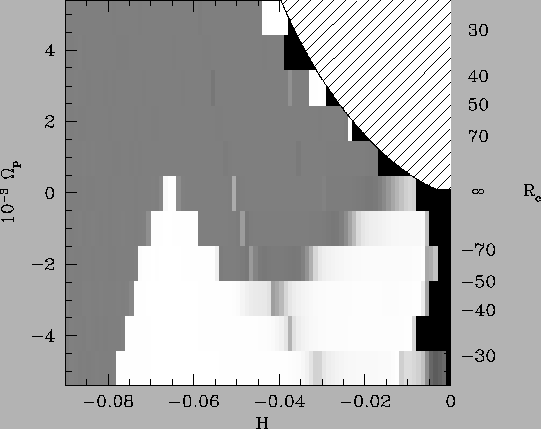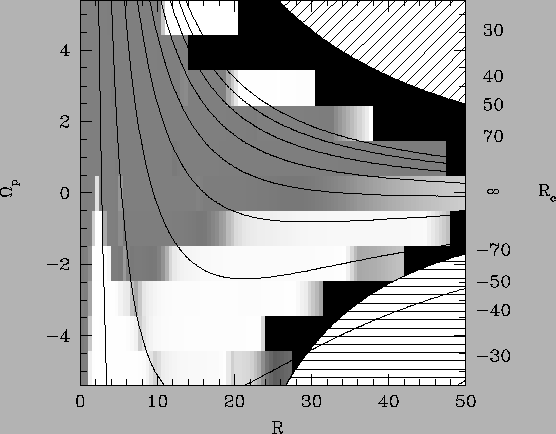To study the influence of the rotation, we first look for
Lagrangian points.
The latter are found by setting the right terms of equations (6) to zero.
Substituting ![]() ,
, ![]() and
and ![]() , the Lagrangian points are solutions of the following equations :
, the Lagrangian points are solutions of the following equations :
Despite the fact that a direct and retrograde rotations respectively add and remove
resonances, the type of bifurcations as well as the stability and the shape of orbits are
not affected by a global pattern speed.
This has been tested in the range ![]() and
and
![]() , where
, where ![]() is the corotation radius and a negative value corresponds to a retrograde rotation.
is the corotation radius and a negative value corresponds to a retrograde rotation.
For a radius less than
![]() , both prograde and retrograde 1:1
resonances are not observable in this range of pattern speed.
For a corotation of
, both prograde and retrograde 1:1
resonances are not observable in this range of pattern speed.
For a corotation of
![]() they appear only beyond
they appear only beyond
![]() (resp.
(resp.
![]() ). Thus they have not been studied.
). Thus they have not been studied.
The main influence appears when we look at the consistency of orbits with the mass
density. If the warp is mostly self-gravitating and made of thin and distinct tube
orbits, one can check the self-consistency constraint by noting that the
spatial occupation of a periodic orbit is locally inversely proportional to its
local speed (
![]() ).
The reason is explained by the fact that at a given point of the orbit, the
local speed remains constant in time. This argument is not available at exceptional points,
for example the points where an orbit crosses itself.
Since the density is proportional to the spatial occupation time, it must also
be proportional to the inverse speed along the orbit
(
).
The reason is explained by the fact that at a given point of the orbit, the
local speed remains constant in time. This argument is not available at exceptional points,
for example the points where an orbit crosses itself.
Since the density is proportional to the spatial occupation time, it must also
be proportional to the inverse speed along the orbit
(
![]() ).
Strictly this condition is only fulfilled
by a structure entirely made of distinct exactly periodic orbits, such
as a disk made of circular orbits. Nevertheless the check is useful
in this problem because few hot orbits far from periodic round orbits
are expected to exist.
).
Strictly this condition is only fulfilled
by a structure entirely made of distinct exactly periodic orbits, such
as a disk made of circular orbits. Nevertheless the check is useful
in this problem because few hot orbits far from periodic round orbits
are expected to exist.
In practice, the consistency has been calculated using the indice ![]() defined
by the norm :
defined
by the norm :
We have tested the consistency of families pk with respect to the energy
(Fig. 11) and radius (Fig. 12), which is more convenient in galactic
dynamics.
This as been calculated for different (direct and retrograde)
pattern speeds between ![]() and
and
![]() corresponding to
corresponding to
![]() . The white regions
correspond to
. The white regions
correspond to ![]() (consistency) while the darker
gray correspond to a value of
(consistency) while the darker
gray correspond to a value of
![]() (inconsistency). The shaded parts
give the limit of the computation,
either because of the corotation or because of the positive energy regions. The black
pattern points out the missing data due to computational difficulty arising because of
the proximity of the forbidden regions.
(inconsistency). The shaded parts
give the limit of the computation,
either because of the corotation or because of the positive energy regions. The black
pattern points out the missing data due to computational difficulty arising because of
the proximity of the forbidden regions.
 |
 |
For a direct rotation, except in small regions near the corotation,
the inverse local speed along an orbit varyies exactly in opposition to
the density (
![]() ).
This causes it to depopulate the higher density regions to
the advantage of the lower. The density distribution is also slowly modified.
However, for a slowly retrograde rotation a zone appears around
).
This causes it to depopulate the higher density regions to
the advantage of the lower. The density distribution is also slowly modified.
However, for a slowly retrograde rotation a zone appears around
![]() ,
where the inverse local speed varies exactly as the density.
This latter is also reinforced and the potential is self-consistent.
This zone grows with increasing rotation and a second zone appears for larger radii.
For a corotation smaller than
,
where the inverse local speed varies exactly as the density.
This latter is also reinforced and the potential is self-consistent.
This zone grows with increasing rotation and a second zone appears for larger radii.
For a corotation smaller than
![]() the zones of consistency cover
the whole disk under the curve of zero energy.
the zones of consistency cover
the whole disk under the curve of zero energy.
The same work applied to the subfamilies ![]() reveals that they are
clearly inconsistent with the
density distribution, but these families are also less relevant with the assumption
of almost circular rotation.
reveals that they are
clearly inconsistent with the
density distribution, but these families are also less relevant with the assumption
of almost circular rotation.